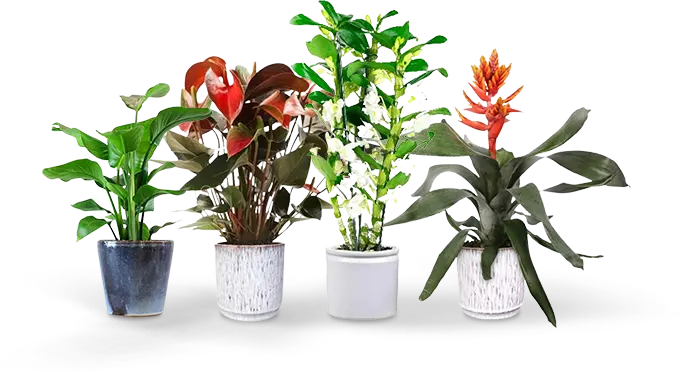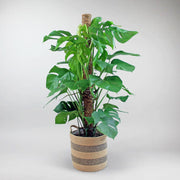Flowering House Plants
King Anthurium
Regal Anthurium
Aglaonema 'White Joy'
Pink Polka Lipstick Plant
Cider Gum
Aglaonema Arctic Lime
Aglaonema Stripes
Queen of Hearts Anthurium
Aglaonema 'Coco Melon'
Turtle Shell Anthurium
Aglaonema Christina
Velvet Leaf Anthurium
Dragon Breath Alocasia
Crystal Anthurium
Villena Anthurium
Beefsteak Plant
Silver Blush Anthurium
Syngonium Mottled
Beauty Kim
Calathea Dottie
Why Choose Flowering Plants?
- Aesthetic Appeal: Flowering plants bring a stunning array of colors and forms, creating a visual feast for the eyes.
- Mood-Enhancing Benefits: Studies show that having flowering plants in your surroundings can boost mood and reduce stress levels.
- Diverse Choices: From fragrant Jasmine to long-lasting Anthuriums, there's a flowering plant to suit every taste and space.
Tips for Selecting the Best Flower Plants
- Light Needs: Assess the sunlight availability in your space to choose the right plant.
- Seasonal Suitability: Select plants that align with your region’s climate for optimal growth.
- Care Level: Consider low-maintenance options like areca palm if you're new to gardening.
Best Flower Plants for Your Space
- Indoor Favorites: Orchids and African Violets thrive indoors, offering elegance and minimal upkeep.
- Outdoor Beauties: Geraniums and Marigolds add vibrant colors to gardens, patios, or balconies.
- All-Season Blooms: Plants like Begonias and Hydrangeas provide consistent charm throughout the year.
Brighten Your Space Today
Explore our collection of flowering plants to find the best flower plants for your home or garden. Enjoy vibrant colors, delightful fragrances, and an instant uplift to your surroundings!
Flowering Plants FAQ
How To Fertilise Flowering Plants?
Flowering plants will usually require some level of fertilising to ensure that they have sufficient nutrients to bloom. The best time to fertilise your indoor flowering plants is during their particular growing season, usually the spring and summer months. Most plants don’t need to be fertilised during the dormant months, as the nutrients will just go to waste.
It’s always best to check the individual care instructions of your flowering plant and the instructions on your fertiliser. For flowering plants you are probably best going with a complete fertiliser, also often referred to as ‘NPK’ fertiliser. NPK stands for the 3 essential nutrients: Nitrate, Phosphorus, and Potassium.
Complete fertilisers will have a ratio that will look something like 20:20:20, which refers to the percentage of each of these nutrients in the fertiliser. The best fertilisers for flowering plants are those with higher phosphorus levels, so choose the one with the highest number corresponding to the ‘P’.
Each plant will be slightly different but generally, you can fertilise your flowering plants every couple of weeks during the warmer months, and omit fertilising completely during the cooler dormant months.
What Are The Best Flowering House Plants To Grow Indoors?
Here are some of our favourite flowering plants to grow indoors:
Calamondin Orange Tree (Citrus mitis 'Calamondin')
The Calamondin Orange Tree will forever be one of our favourite indoor plants with its beautiful foliage and delicate sweet orange scent.
Another great thing about Calamondin Orange Trees is that they are relatively easy to look after, so even if you’re not the most green-fingered, you can still enjoy all the benefits of this flowering plant.
Try to keep your orange tree somewhere it will get lots of light and away from any drafts while remembering to water them roughly 2-3 times per week. But if you do forget on occasion, don’t worry, because they are relatively hardy little trees!
Pineapple Plant (Ananas comosus 'Pygmy Amigo')
Certain to be a showstopper, this tropical beauty is among the most unique-looking indoor flowering plants with its singular ornamental pineapple!
Keep your pineapple plant in a bright warm room, check the moisture of the soil weekly and water when the top 2 cm has dried out.
Lemon Tree (Citrus Limon)
Ah, the lovely lemon tree! Another of our favourite fruity flowering plants with its subtly sweet citrus scent and bright yellow lemon fruits. Lemon trees are also relatively hardy little trees and will tolerate lower light conditions and are quite forgiving if you forget to water them.
If you want lots of lovely fruit, place it in a bright sunny spot and try to water it a couple of times a week.
Olive Tree (Olea Europaea)
If you’re a little on the forgetful side, then an olive tree might just be the flowering plant for you. Just like in the Mediterranean, these pretty indoor flowering plants like it hot! This means that they prefer to be kept in warm, sunny conditions, and they’ll graciously forgive you if you forget to water them every now and then.
Can Flowering Plants Grow Outdoors?
Absolutely! Different flowering plants require different living conditions, so depending on factors such as where in the world you live and their individual requirements, some flowering plants will fare better indoors and others will thrive outdoors. Some of the best flowering plants for keeping outside in the UK are lavender, geraniums, and hydrangeas. It’s important to consider the light conditions of the area they’re going to be placed. Some flowering plants will be able to tolerate lots of bright direct light, but this could damage the foliage of others.
Do Flowers Need Direct Sunlight?
Not all of them! Actually, a lot of flowering plants are happiest with bright but indirect sunlight, as this keeps their foliage safe from burning. All plants need some light in order to photosynthesise, so it’s important to make sure that your flowering plants are kept in an area where they get at least a few hours of light every day. Before you purchase a new plant, it’s best to do your research on that plant to make sure you have somewhere suitable to keep it.
Can I Keep Flowering Plants In Plastic Containers?
Yes, for a while! If your flowering plant comes in a plastic container, then you can keep it in there for a while. However, you will need to repot your plant at some point, as it will eventually outgrow its container. It is better to choose a more sustainable material than plastic when repotting. However, those that need their soil to be kept moist will do the best in plastic pots as they tend to retain water more.





































